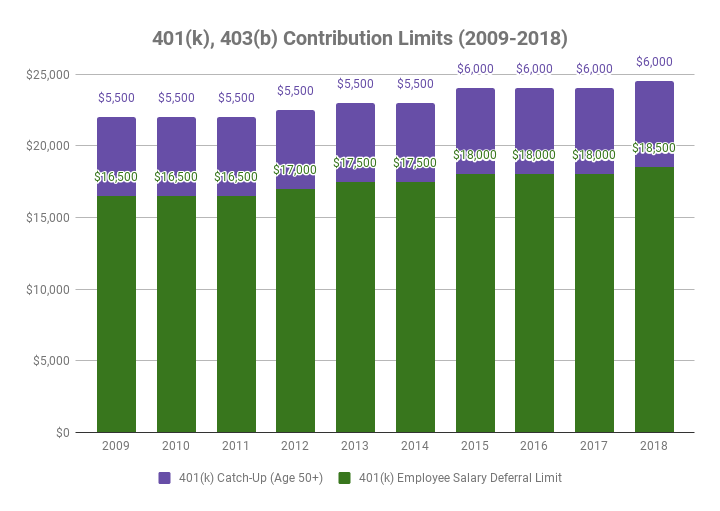
Employer-based retirement plans like the 401(k), 403(b), most 457 plans, and the federal government’s Thrift Savings Plan are not perfect, but they are often the best available option to save money in a tax-advantaged manner. For 2018, the employee elective deferral (contribution) limit for these plans increased to $18,500 (they are indexed to cost-of-living). The additional catch-up contribution allowed for those age 50+ is $6,000.
Here’s a historical chart of contribution limits for the last 10 years (2009-2018).

| Year | 401k/403b Elective Deferral Limit | Additional Catch-Up Allowed (Age 50+) |
| 2009 | $16,500 | $5,500 |
| 2010 | $16,500 | $5,500 |
| 2011 | $16,500 | $5,500 |
| 2012 | $17,000 | $5,500 |
| 2013 | $17,500 | $5,500 |
| 2014 | $17,500 | $5,500 |
| 2015 | $18,000 | $6,000 |
| 2016 | $18,000 | $6,000 |
| 2017 | $18,000 | $6,000 |
| 2018 | $18,500 | $6,000 |
The limits are the same for both Roth and “Traditional” pre-tax 401k plans, although the effective after-tax amounts can be quite different. Employer match contributions do not count towards the elective deferral limit. Curiously, some employer plans set their own limit on contributions. A former employer of mine had a 20% deferral limit, so if your income was $50,000 the most you could put away was $10,000 a year.
Also see: IRA Historical Contribution Limits 2009-2018
Sources: IRS.gov, IRS.gov COLA Table [PDF]
 The Best Credit Card Bonus Offers – 2025
The Best Credit Card Bonus Offers – 2025 Big List of Free Stocks from Brokerage Apps
Big List of Free Stocks from Brokerage Apps Best Interest Rates on Cash - 2025
Best Interest Rates on Cash - 2025 Free Credit Scores x 3 + Free Credit Monitoring
Free Credit Scores x 3 + Free Credit Monitoring Best No Fee 0% APR Balance Transfer Offers
Best No Fee 0% APR Balance Transfer Offers Little-Known Cellular Data Plans That Can Save Big Money
Little-Known Cellular Data Plans That Can Save Big Money How To Haggle Your Cable or Direct TV Bill
How To Haggle Your Cable or Direct TV Bill Big List of Free Consumer Data Reports (Credit, Rent, Work)
Big List of Free Consumer Data Reports (Credit, Rent, Work)
What were the limit on total contributions (employee pre-tax/roth + employer + post-tax)? I feel this article is incomplete without this.
I’ll disagree on a minor point to say that the TSP is pretty close to perfect. Rock-bottom fees, access to the G fund (no principal risk/high relative fixed rate) and solid match (5% for most employees) it’s an amazing plan. I mean I can quibble over the limitation to EAFE foreign markets (i.e. only large stocks, no Korea, no Canada, no emerging markets) or the lack of REIT exposure but that can mostly be compensated for with an IRA or taxable accounts at Vanguard.
It would be nice to see the historical contributions from 20 years ago, to see how much it was. 401k used to be lower